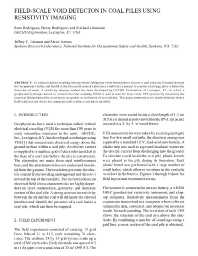Mining Publication: Field-Scale Void Detection in Coal Piles Using Resistivity Imaging
Original creation date: July 2002
To reduce fatalities resulting from personnel falling into voids formed above feeders in coal piles, the National Institute for Occupational Safety and Health at the Spokane Research Laboratory established a project to monitor coal surge piles to detect the formation of voids. A resistivity imaging method has been developed by GECOH Exploration, of Lexington, KY, in which a geophysical technique known as vertical electrical sounding (VES) is used to scan for these voids. VES operates by measuring the electrical field produced by a current in the ground at the bottom of the coal pile. This paper summarizes the results obtained from a field-scale test and shows that mapping voids within a coal pile is possible.
Authors: R Rodriguez, H Rodriguez, M Lhamond, JC Johnson, SR Iverson
Conference Paper - July 2002
NIOSHTIC2 Number: 20030439
NARMS-TAC 2002, "Mining and Tunnelling Innovation and Opportunity," Proceedings of the 5th American Rock Mechanics Symposium and the 17th Tunnelling Association of Canada Conference, July 7-10, 2002, Toronto, Ontario, Canada. Hammah R, Bawden W, Curran J, Telesnicki M, eds., Toronto, Ontario, Canada: University of Toronto Press, 2002 Jul; 1:415-419
See Also
- Derating Factors for Round and Flat Mine Trailing Cables
- Effect of Coal Type and Oxyfuel Combustion Parameters on Pulverised Fuel Ignition
- Gas Sorption and Transport in Coals: A Poroelastic Medium Approach
- Measuring the Gas Content of Coal: A Review
- Methane and Dust Control by Water Infusion: Pittsburgh Coalbed (Fairview, W. Va.)
- Methane Diffusion Parameters for Sized Coal Particles: A Measuring Apparatus and Some Preliminary Results
- Methane Emissions from Gassy Coals in Storage Silos
- Reducing Hazards in Underground Coal Mines Through the Recognition and Delineation of Coalbed Discontinuities Caused by Ancient Channel Processes
- Removing Methane (Degasification) from the Pocahontas No. 4 Coalbed in Southern West Virginia
- Reservoir Engineering Considerations for Coal Seam Degasification and Methane Control in Underground Mines
- Page last reviewed: 6/29/2015
- Page last updated: 6/29/2015
- Content source: National Institute for Occupational Safety and Health, Mining Program


 ShareCompartir
ShareCompartir
